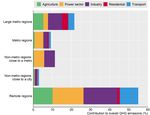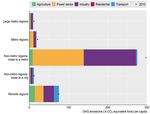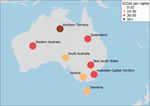Australia Progress in the net zero transition - OECD
←
→
Page content transcription
If your browser does not render page correctly, please read the page content below
Regional Outlook 2021 - Country notes
Australia
Progress in the net zero transition
PUBE
Disclaimer (for the referring document)
This document, as well as any data and map included herein, are without prejudice to the status of or sovereignty
over any territory, to the delimitation of international frontiers and boundaries and to the name of any territory, city
or area. Extracts from publications may be subject to additional disclaimers, which are set out in the complete
version of the publication, available at the link provided.2|
EMISSIONS
2018 OECD average: 2018 Australian average: Australian net zero target:
11.5 tCO2e/capita 22.4 tCO2e/capita All states aim for 2050.
Large regions (TL2)
Figure 1. Estimated regional greenhouse gas emissions per capita Greenhouse gas (GHG) emissions
Tons CO2 equivalent (tCO2e), large regions (TL2) , 2018 per capita generated in all Australian
large regions are above the OECD
average of 11.5 tCO2e.
Estimated emissions per capita in
Northern Territory are more than three
times higher than in Victoria.
Small regions (TL3)
Figure 2. Contribution to estimated GHG emissions Figure 3. Estimated GHG emissions per capita
By type of small region, 2018 By type of small region, 2018
Across the OECD, metropolitan regions emit more greenhouse gases than remote regions. In Australia, the reverse
is true. Emissions in Australian remote rural regions are much higher than in metropolitan regions also per capita. The
difference is more pronounced than for the average OECD country. Australia has one non-metro region close to a
small city (Hunter Valley Exc Newcastle). It has very high per capita emissions for energy and industry.
Target notes: Emissions targets included in the Net Zero Tracker database from ECIU before January 25, 2021 are considered.
Figure notes: Figures 1, 2, 3 and the OECD average show OECD calculations based on estimated greenhouse gas emissions data from the European Commission’s Joint
Research Centre (ECJRC). The Emissions Database for Global Atmospheric Research of the ECJRC allocates national greenhouse gas emissions to locations according to
about 300 proxies. See Box 3.7 in the 2021 OECD Regional Outlook for more details.|3
ENERGY
Australian electricity mix
Figure 4. National electricity generation by energy source in 2019
Share of coal-fired electricity generation
2030 well below 2°C benchmark for Asia Pacific:
2019 Australian average:4|
Wind power
2030 well below 2°C benchmark for Asia
2019 OECD average: 8% 2019 Australian average: 7%
Pacific: >13%
Figure 6. Regional wind power generation estimates Figure 7. Wind power potential
Per cent of total electricity generation, large regions (TL2), 2017 Mean wind power density (W/m2)
Regional wind electricity generation is estimated using facility level data for 92%
of Australia’s wind capacity.
Source: Map produced by The Global Wind Atlas
Solar power
2030 well below 2°C benchmark for Asia
2019 OECD average: 3% 2019 Australian average: 6%
Pacific: >15%
Figure 8. Regional solar power generation estimates Figure 9. Solar power potential
Per cent of total electricity generation, large regions (TL2), 2019 Global horizontal irradiation (kWh/m2)
Source: Map produced by The Global Solar Atlas
Australia has very strong solar potential, particularly in Western Australia and Northern Territory. Wind power density
is strongest in South and Western Australia. Yet solar and wind generation are a fraction of benchmarks for 2030 also
in these regions.
Benchmark notes: The well-below 2 degrees benchmarks show IEA Sustainable Development Scenario (SDS) numbers. The SDS models how the global energy system can
evolve in alignment with the Paris Agreement’s objective to keep the global average temperature increase well below 2°C above pre-industrial levels. According to the Powering
Past Coal Alliance (PPCA), a phase-out of unabated coal by 2030 for OECD countries is cost-effective to limit global warming to 1.5°C.
Figure notes: Figure 4 shows data from the IEA (2020). Figures 5 and 6 show OECD calculations based on the Power Plants Database from the WRI. The database captures
electricity generation from the power plants connected to the national power grid. As a result, small electricity generation facilities disconnected from the national power grid might
not be captured. See here for more details. Figure 5 also includes coal plans (defined as new capacity announced, pre-permit, permit or in construction) from the Global Coal
Plant Tracker published by Global Energy Monitor. Figure 8 uses data from the Australian Energy Update 2020 published by the Department of Industry, Science, Energy and
Resources from the Australian Government Figures 7 and 9 show the power potential of solar and wind. Mean wind power density (WPD) is a measure of wind power available,
expressed in Watt per square meter (W/m²). Global horizontal irradiation (GHI) is the sum of direct and diffuse irradiation received by a horizontal surface, measured in kilowatt
hours per square metre (kWh/m2).|5
SECTORAL EMPLOYMENT RISKS
Figure 10. Employment in selected sectors which may be subject to employment loss by 2040 if emissions
are reduced in line with the Paris climate agreement
Per cent of total regional employment, large regions (TL2), 2017
There will be both employment gains and losses due to the transition to net zero greenhouse gas emissions. They
may not be distributed in the same way across regions. Employment in sectors that may be subject to some job loss
by 2040 as a result of policies to reduce emissions in line with the climate objectives in the Paris Agreement amounts
to less than 2.5% in all Australian regions. Most Australian regions have less employment in these sectors than the
OECD average. Queensland has a larger share, largely driven by coal and other mining as well as other
manufacturing. The selection of sectors is broad and based on employment effects simulated across OECD countries
(See Box 3.9 of the 2021 OECD Regional Outlook). It does not take specific local characteristics into account.
Coal
Figure 11. Regions with employment in mining of coal and lignite, and regional socio-economic indicators
Large regions (TL2) with employment in selected sector, 2017
To be aligned with the Paris Climate Agreement, coal production in the Asia-Pacific Region would need to fall by
more than a half until 2040, according to the IEA’s Sustainable Development Scenario. Australian employment in
the sector is largest in Queensland. The transition needs to be just, avoiding social hardship. Australian regions with
the largest shares of employment in coal mining sector are not necessarily the worst performers in terms of GDP
per capita, long-term unemployment and relative poverty.
Figure notes: Figures 10 and 11 are based on data from OECD Statistics. In Figure 10 sectors are selected based on macroeconomic simulations of a scenario limiting global
warming to well below 2 degrees. See Box 3.9 in the 2021 OECD Regional Outlook for more details. In figure 11, poverty risk is assessed from individuals’ survey respondents
indicating there have been times in the past 12 months when they did not have enough money to buy food that they or their family needed. Long-term unemployment is defined
as unemployed for 12 months or more.6|
TRANSPORT
Electrification of passenger cars
Benchmarks for new zero-
emission passenger car sales:
Australian target sales of zero
2019 Australian average share of IEA well-below 2°C benchmark: emission new passenger cars:
full-electric new passenger car 100% by 2040.
sales:|7
AIR POLLUTION
Large regions (TL2)
2019 Australian share of
2019 OECD share of population WHO-recommended air quality
population exposed above the
exposed above the WHO- threshold: PM2.5 annual mean
WHO-recommended threshold:
recommended threshold: 62% concentration < 10 µg/m3
0.4%
Figure 14. Share of population exposed to levels of air pollution above the WHO-recommended threshold
Percentage of population exposed to above 10 µg/m3 PM2.5, large regions (TL2), 2019
Policies towards net-zero greenhouse gas emissions can bring many benefits beyond halting climate change. They
include reduced air and noise pollution, reduced traffic congestion, healthier diets, enhanced health due to increased
active mobility, health benefits through thermal insulation, and improved water, soil and biodiversity protection. Some
are hard to quantify.
Small particulate matter (PM2.5) is the biggest cause of human mortality induced by air pollution, but few Australians
are exposed. Major disease effects include stroke, cardiovascular and respiratory disease. Air pollution amplifies
respiratory infectious disease such as Covid-19. It affects children the most. It reduces their educational outcomes as
well as worker productivity. Exposure to small particulate matter air pollution in all Australian regions is low.
Figure notes: Figure 14 is based on data from OECD Statistics.You can also read



























































